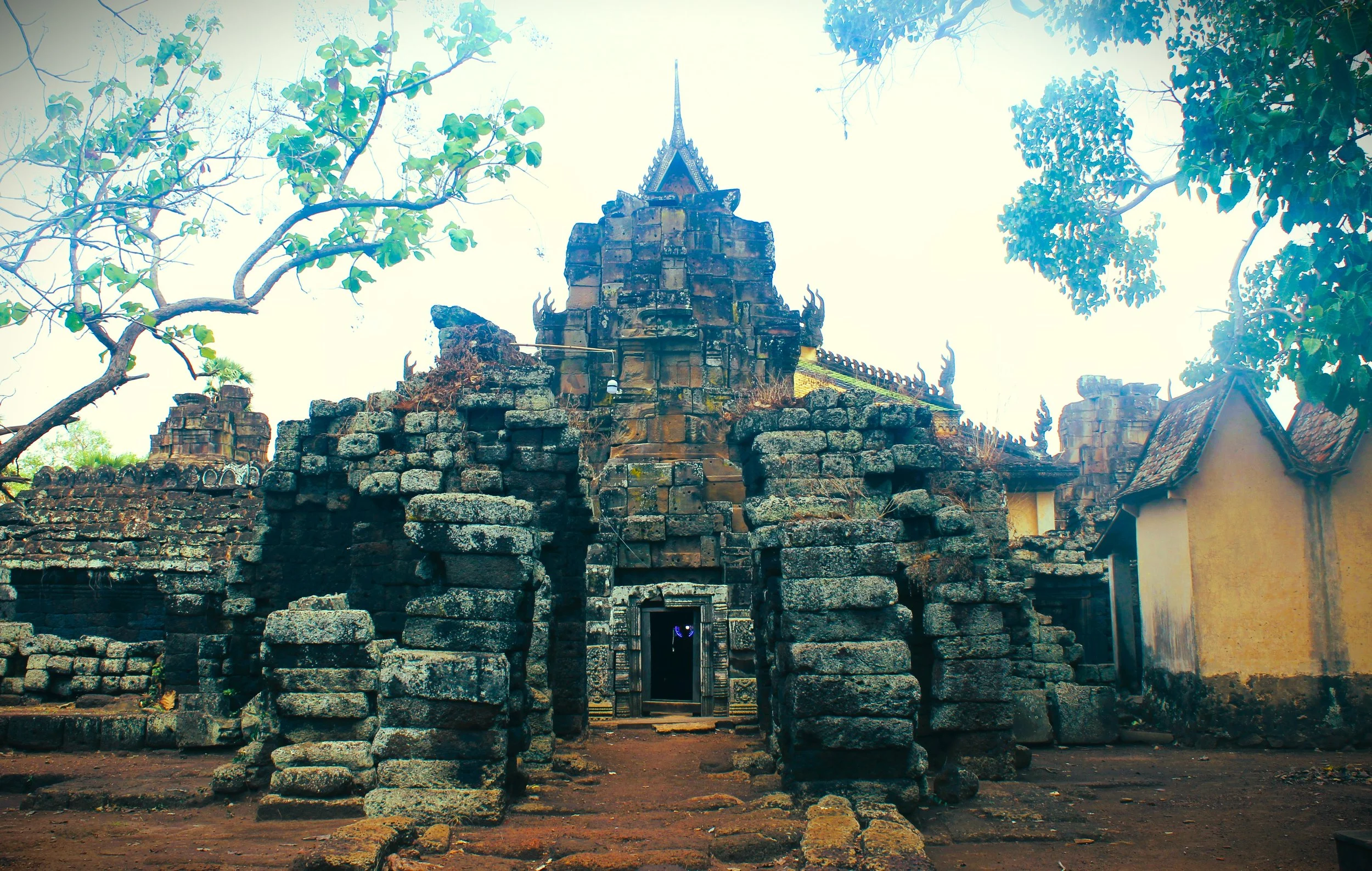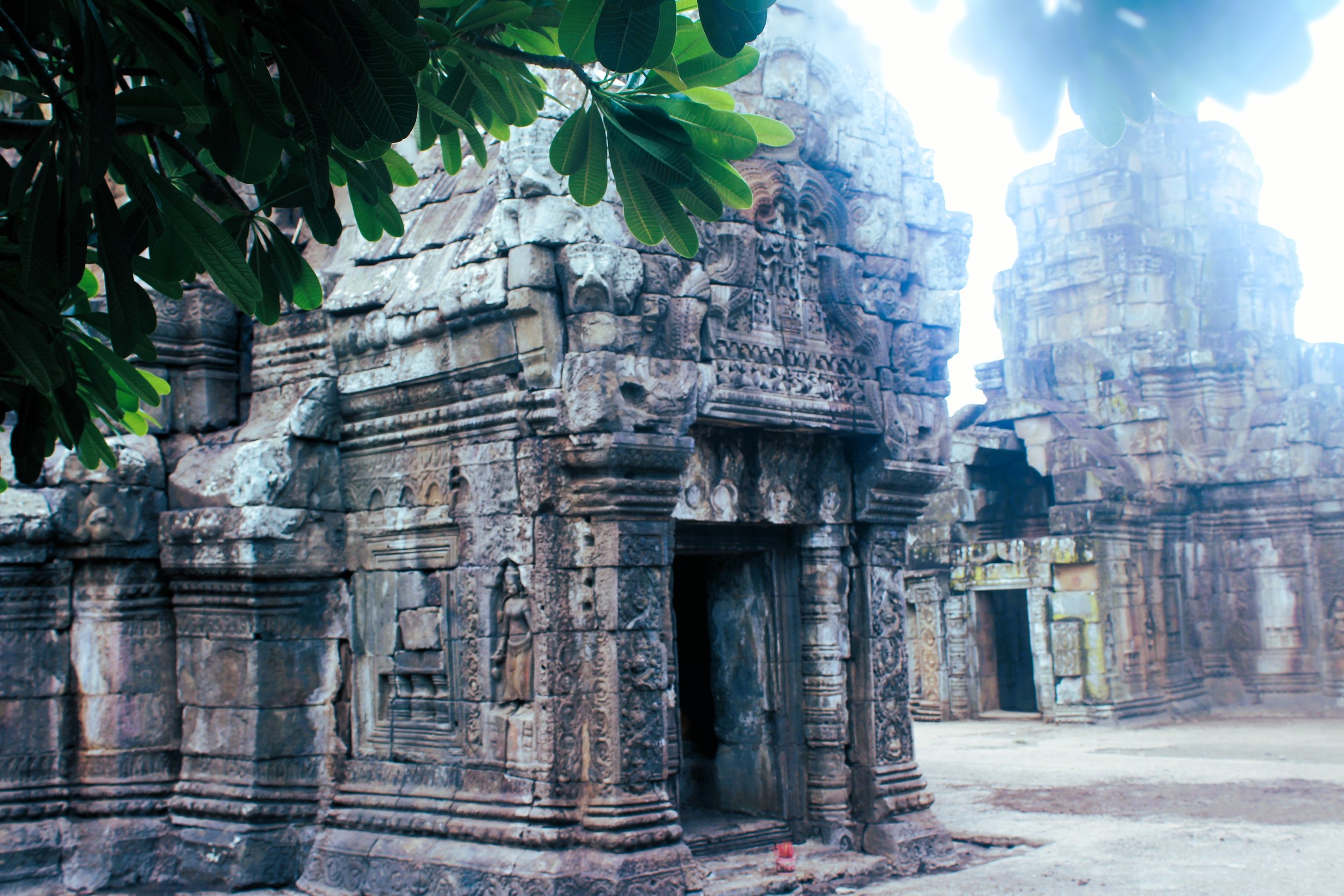Discover Echoes of Angkor at Wat Nokor Bachey
Map pins rarely hint at emotion. The tiny dot that marks Wat Nokor Bachey hides a world of incense and sandstone, drumbeat and fruit‑bat wing. Two kilometres north‑west of Kampong Cham’s riverside cafés, the temple looks almost humble when glimpsed from National Road 7. Step through the weather‑softened gate and that first impression dissolves. Incense drifts in the heat, saffron robes flicker through shadowed doorways, and carvings older than Notre‑Dame glow where the morning sun touches them. Many travellers plan a twenty‑minute stop yet leave hours later, pleasantly dazed by the play of history and everyday life under the banyan trees.
Many Names, One Palace of Stone
Friends in Kampong Cham often tell us they are heading to Wat Angkor, a local nickname that can confuse travellers who picture Angkor Wat far away in Siem Reap. Guides and brochures usually write Wat Nokor Bachey, yet both names lead to the same quiet sanctuary just beyond the city.
A Temple Built, Reimagined and Still Beating
From the city centre, the route to the temple is quick but atmospheric. After leaving the main riverside road, we pass the roundabout where four sculpted nāga coil protectively around a central plinth. From here, a small turning leads away from the traffic and into farmland. The road becomes quiet, dustier, lined with trees and houses on stilts. We often pass boys balancing barefoot on fences, women weaving baskets in shade, and slow-moving scooters carrying families of five. The final bend opens onto a tamarind-framed entrance—Wat Nokor Bachey revealed without ceremony, as if it had always been part of the landscape.
From that first view, it can seem like a quiet village pagoda. But these unassuming walls lead inward, into a cruciform layout that dates back nearly a millennium. To understand what we’re looking at—to feel the weight of the lintels, the reason the roots cling so tightly to the stone—we need to step back into history, and into the reigns of kings who carved their power and penance into the very walls still standing today.
First Stones under Suryavarman II
We trace the earliest chapters to the reign of King Suryavarman II in the opening decades of the twelfth century. His engineers quarried laterite blocks from the Mekong floodplain, then slid each tongue‑and‑groove slab into place without a smear of mortar. They paved the courtyard with crushed laterite, channelled run‑off toward two rectangular ponds, and left enough bare earth for sacred trees to take root. In the innermost chamber they placed a linga, the unmistakable emblem of Shiva, signalling that this new sanctuary belonged to the Hindu cosmos.
The masons crowned every doorway with dark sandstone lintels. Look closely and you will still see floral tendrils curling around mythic beasts, delicate patterns that resisted eight hundred seasons of monsoon and dust. Their survival reminds us that Khmer sculptors once chased details as fine as a lotus filament, even when those details would rest high above a worshipper’s head.
The Buddhist Voice of Jayavarman VII
Less than a lifetime later King Jayavarman VII remade the empire in stone, and Wat Nokor Bachey joined the transformation. Hindu deities ceded their pediments to gentle bodhisattvas. Apsaras appeared in fluid poses, lips curved in half‑smiles that seem to follow us along the eastern gallery. At dawn the angled light skims their profiles, animating sandstone so convincingly that more than one visitor has admitted we half‑expected a dancer to step free of the wall.
Jayavarman’s artisans also inscribed verses in ancient Khmer. One damaged stanza still hints at a royal vow of atonement, weaving this provincial shrine into larger tales of power, remorse and redemption that play across Angkor Thom.
Living Faith in the Twentieth Century
Centuries passed, kingdoms rose and fell, yet villagers continued to pray among the laterite ruins. In the 1930s they raised a concrete Theravada vihara within the cruciform heart of the Angkorian chapel. The result feels like nesting dolls—laterite shell, sandstone sanctuary, vivid modern pagoda—all inhaling together beneath one roof. Electric fans hum overhead. Murals explode in tropical greens and sunset oranges, retelling the life of the Buddha. Our sandals crunch on ancient thresholds while fluorescent halos flicker above gilded statues, a simple proof that faith can renovate without erasing.
Today novice monks sweep leaves, toddlers chase each other between doorways, and vines crawl wherever human hands pause too long. The complex has avoided the polished restorations of Angkor Wat, allowing banyan roots to brush lintels and lichen to map out pale continents on basalt‑dark stone. Some call it disrepair, yet many visitors tell us that the gentle decay feels honest, as though the place is ageing rather than posed.
Moments That Linger in Memory
One traveller told us the bats trumped even the carvings. Arrive near dusk and watch a river of fruit bats pour from roof crevices, swirl once above the pagoda spire, then vanish into the indigo sky. Another guest lingered until the long drums began, a pulse that summons monks for sunset chanting. Mix those rhythms with the sweet‑sharp scent of frangipani and you have an experience no lens can trap.
Stone still claims its share of awe. The eight‑armed bodhisattva at the western door greets us with a smile softened by centuries of rain. In the north‑east corner a slender apsara keeps her fingertips razor‑sharp while the wall behind her flakes away. We like to stand alone before these carvings, letting our own breath fall into cadence with the cicadas.
Practical Advice for Curious Travellers
Need to Know Details
Opening Hours Roughly 07:00 to 18:00. Interior doors may close early during evening chanting.
Ticket 2 USD covers Wat Nokor Bachey plus Phnom Pros and Phnom Srei. Buy at the small kiosk inside the gate, not from roadside touts.
Brochures Free leaflets in Khmer and English sit on a folding table near the ticket window.
Group Size Smaller groups soak up the echoes. Large tours drown the cicadas.
Dress Code Shoulders and knees covered, shoes off inside the pagoda, cameras down during prayer.
Getting to the Temple
Setting Out from Kampong Cham Riverside
Begin at Smile Restaurant beside the Mekong. Order iced coffee strong enough to wake the river. Tuk‑tuks gather outside from dawn; a six‑dollar round trip brings us to the temple in under ten minutes. The route passes tobacco barns sweet with curing leaves and peppercorn sheets laid out to dry. Cycling is easy too. The road stays flat, tree‑lined and alive with waving children.
Rolling Down from Hanchey Bamboo Resort
Our riverside retreat rests forty‑five minutes upstream and we organise tuk‑tuk tours for our guests running in the morning and afternoon, weaving past rice paddies and down the banks of the Mekong into Kampong Cham City. Our guides can ensure you pick up the official tickets, freeing you to walk straight into the sanctum and explore the splendor of Nokor Bachey hassle-free.
Phnom Pros and Phnom Srei
The two hills included in the ticket rise seven kilometres beyond Wat Nokor Bachey. Folk legend says monks and nuns raced to build them in one night; the women won when gods tricked the men into ending their shift early. Climb 308 steps on Phnom Srei for a breezy view of the Mekong’s silver ribbon. Macaques patrol the balustrade, ever hopeful for an unguarded snack.
Preservation, People and Dance
Entrance fees patch roofs and stabilise leaning galleries, while our partnership with BSDA (Buddhism for Social Development Action) funnels revenue into basic, vocational and hospitality training for local youth. Festival evenings sometimes bring classical Khmer dance to the outer courtyard where silk skirts flare, ankle bells chime, and the old stone echoes with stories told in movement.
Leaving Quietly
Angkor Wat draws the postcards, yet Wat Nokor Bachey offers intimacy. We may share a gallery with a single monk whispering Pali, a grandmother laying lotus buds at a weathered Buddha, or no one at all but the bats above. The temple waits for patient footsteps. Walk slowly, breathe deeply, let nine hundred years of prayer rise around us.
Aw‑kun ch’ran. May the memory of Nokor Bachey travel with us long after our sandals leave its ancient stone.



